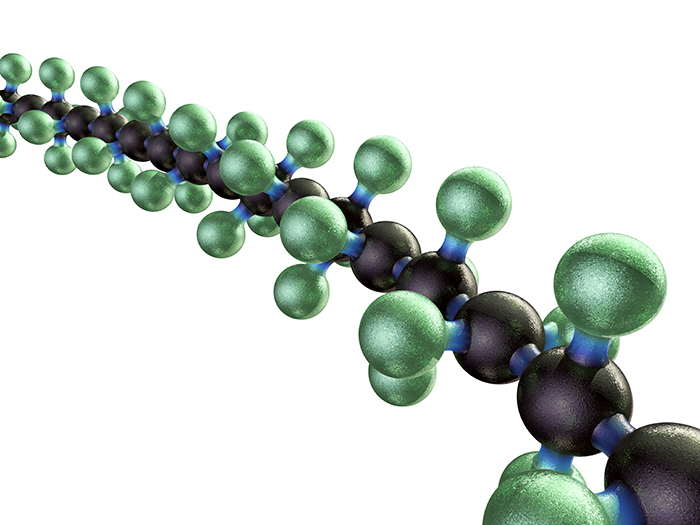The history and evolution of “the forever molecule” is both revolutionary and fortuitous. Polytetrafluoroethylene, or PTFE, was discovered completely by accident on April 6th, 1938 by a DuPont Chemist, Dr. Roy Plunkett, while he was conducting research on chlorofluorocarbon refrigerants. Its first broad commercial use was non-stick cookware in 1960. PTFE has since evolved and is utilized in an extensive array of products that take advantage of its unique properties.
PTFE is inert to virtually all chemicals and is considered the most slippery material in existence. The carbon-fluorine bond is one of the strongest single bonds in nature, giving the molecules their persistence in the environment and their “forever” moniker.
PTFE fibers are applied to many applications and have advantages over other materials. PTFE is utilized in medical implanted products, air and liquid filtration, and technical textiles, just to name a few. These fibers can be sewn, knitted, woven or nonwoven into various structures and offer excellent performance in a range of challenging environments. These products are waterproof, UV resistant, and can be exposed to continuous temperatures of 260 C to absolute zero -273 C.
Sounds great, right? Not so fast … PTFE poses significant health and environmental issues when exposed to high temperatures, as it off gasses a perfluorooctanoic acid (PFOA), which has shown to be a carcinogen in rats. PTFE has also been discovered in dolphins off the Florida coast and polar bears in the Arctic; it is present, according to a range of studies, in the bloodstream of almost every person — and even in newborns. The exposure in people is often linked to non-stick cookware, which is utilized in almost every home and many commercial kitchens. PFOAs typically have a four-year half-life in the bloodstream.
PTFE is unique because of its properties. Those properties enable its resistance to almost every chemical on earth, and that resistance enables its persistence in the environment, which includes us.
The drive toward the circular economy will inevitably put pressure on the manufacturers and end-users of PTFE. Global PTFE demand is forecasted to exceed 240,000 metric tons, according to a recent Companies and Markets report. The largest PTFE recycling plant in the world, operated by 3M subsidiary Dyneon GmbH, is located in Southern Germany and has an annual capacity of 500 metric tons.
While there are several companies around the world that can recycle PTFE, the majority is being landfilled. The recycling of PTFE can be facilitate via two different processes, each with different end outcomes. One involves irradiation of the PTFE with a powerful dose of ionizing irradiation, which reduces PTFEs molecular weight and then pulverizing it into micro power with limited reuse. The second method involves pulverizing the PTFE scrap without irradiation, which expands its reuse to similar uses as virgin-grade PTFE. Among all plastics, PTFE has the least stability against Ionizing radiation, a property which is used to break down carbon-carbon bonds in the polymer chain.
A specific application for PTFE is when the material is stretched to create what’s termed an expanded PTFE (ePTFE) membrane. These membranes are utilized in the protection of people, the environment, and in areas where controlling contamination in filtration and separation is critical. These membranes are far too delicate to be unitized without the aid of a backing material, so they require a secondary lamination for support.
Nanofiber technologies are replacing ePTFE membranes in some filtration products, especially those that do not require wide chemical compatibility and high temperature resistance. Some additional advantages of non-PTFE nanofiber over ePTFE membranes are initial lower product costs in materials and manufacturing, and the product benefits of higher airflows with lower pressure drops.
Another applications where nanofibers are replacing ePTFE is in the core of waterproof and breathable textile laminates like Gore-Tex. Polyester nanofiber cores are replacing PTFE core materials and achieving adequate water repellency and breathability, while also making the garment easier to recycle.
Nanofiber applications continue to grow and drive attention away from PTFE. However, in order to achieve more widespread application, the manufacturing process and material science around nanofiber will need to be refined. The process for making nanofibers requires specific manufacturing infrastructure, which is not fully developed or validated, and this will take time and resources.
The future of PTFE is unknown as the move toward circular economy and more environmentally friendly solutions becomes more prominent. PTFE is unique because of its properties. Those properties enable its resistance to almost every chemical on earth, and that resistance enables its persistence in the environment, which includes us. This plastic saves lives and protects people and environment, while its waste builds up in the environment and is difficult to remove. The first rule of toxicology says, the dose makes the poison. Just because something is present doesn’t mean it’s going to cause harm.


